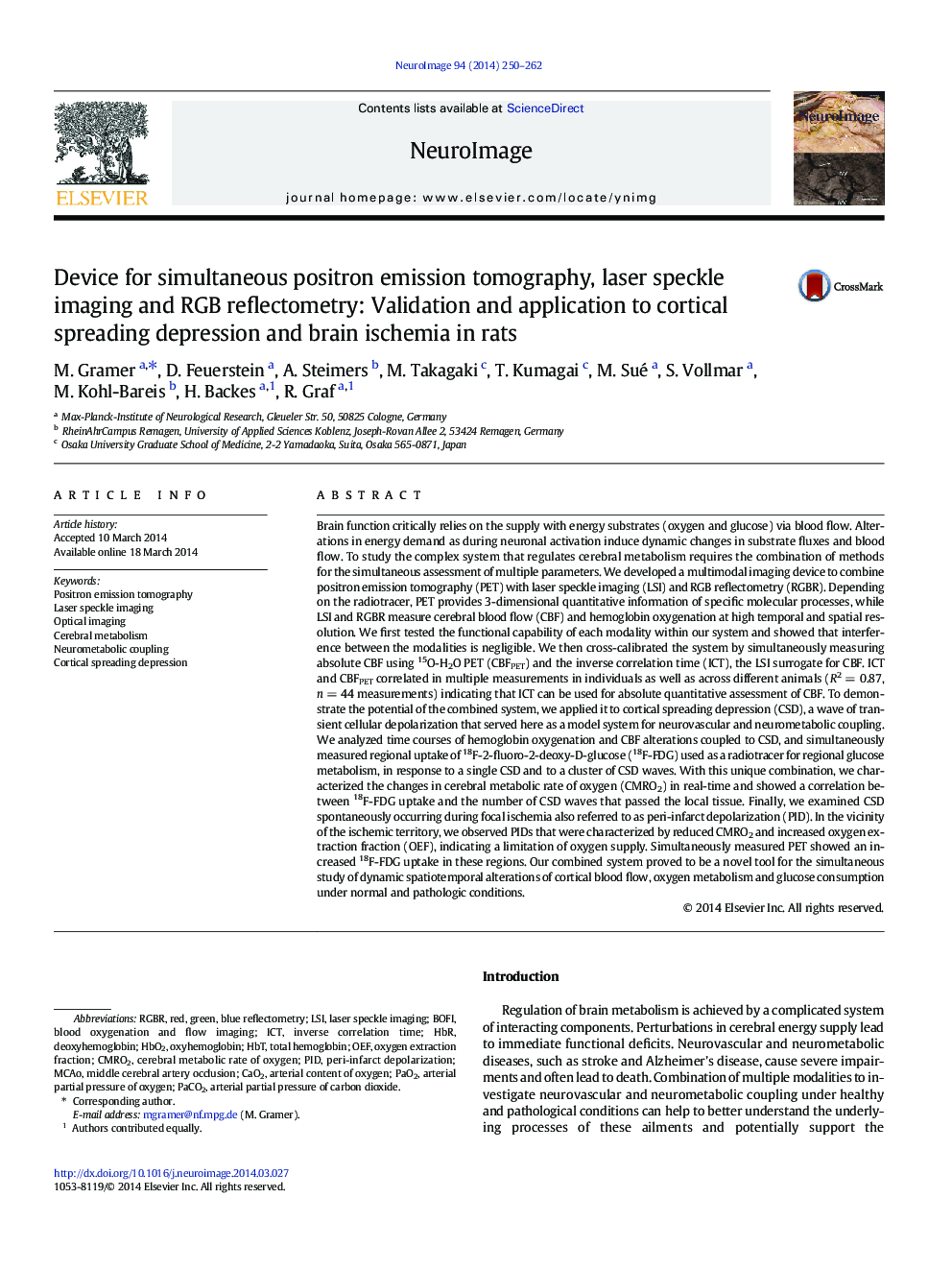| Article ID | Journal | Published Year | Pages | File Type |
|---|---|---|---|---|
| 6027539 | NeuroImage | 2014 | 13 Pages |
Abstract
Brain function critically relies on the supply with energy substrates (oxygen and glucose) via blood flow. Alterations in energy demand as during neuronal activation induce dynamic changes in substrate fluxes and blood flow. To study the complex system that regulates cerebral metabolism requires the combination of methods for the simultaneous assessment of multiple parameters. We developed a multimodal imaging device to combine positron emission tomography (PET) with laser speckle imaging (LSI) and RGB reflectometry (RGBR). Depending on the radiotracer, PET provides 3-dimensional quantitative information of specific molecular processes, while LSI and RGBR measure cerebral blood flow (CBF) and hemoglobin oxygenation at high temporal and spatial resolution. We first tested the functional capability of each modality within our system and showed that interference between the modalities is negligible. We then cross-calibrated the system by simultaneously measuring absolute CBF using 15O-H2O PET (CBFPET) and the inverse correlation time (ICT), the LSI surrogate for CBF. ICT and CBFPET correlated in multiple measurements in individuals as well as across different animals (R2 = 0.87, n = 44 measurements) indicating that ICT can be used for absolute quantitative assessment of CBF. To demonstrate the potential of the combined system, we applied it to cortical spreading depression (CSD), a wave of transient cellular depolarization that served here as a model system for neurovascular and neurometabolic coupling. We analyzed time courses of hemoglobin oxygenation and CBF alterations coupled to CSD, and simultaneously measured regional uptake of 18F-2-fluoro-2-deoxy-D-glucose (18F-FDG) used as a radiotracer for regional glucose metabolism, in response to a single CSD and to a cluster of CSD waves. With this unique combination, we characterized the changes in cerebral metabolic rate of oxygen (CMRO2) in real-time and showed a correlation between 18F-FDG uptake and the number of CSD waves that passed the local tissue. Finally, we examined CSD spontaneously occurring during focal ischemia also referred to as peri-infarct depolarization (PID). In the vicinity of the ischemic territory, we observed PIDs that were characterized by reduced CMRO2 and increased oxygen extraction fraction (OEF), indicating a limitation of oxygen supply. Simultaneously measured PET showed an increased 18F-FDG uptake in these regions. Our combined system proved to be a novel tool for the simultaneous study of dynamic spatiotemporal alterations of cortical blood flow, oxygen metabolism and glucose consumption under normal and pathologic conditions.
Keywords
LSIperi-infarct depolarizationCaO2Neurometabolic couplingOEFOxyhemoglobinPaO2CMRO2HbO2PaCO2HbRdeoxyhemoglobinMCAOPIDcortical spreading depressionmiddle cerebral artery occlusionLaser speckle imagingOptical imagingPositron emission tomographyHBTarterial partial pressure of carbon dioxidearterial partial pressure of oxygenICTCerebral metabolismcerebral metabolic rate of oxygentotal hemoglobinoxygen extraction fraction
Related Topics
Life Sciences
Neuroscience
Cognitive Neuroscience
Authors
M. Gramer, D. Feuerstein, A. Steimers, M. Takagaki, T. Kumagai, M. Sué, S. Vollmar, M. Kohl-Bareis, H. Backes, R. Graf,
